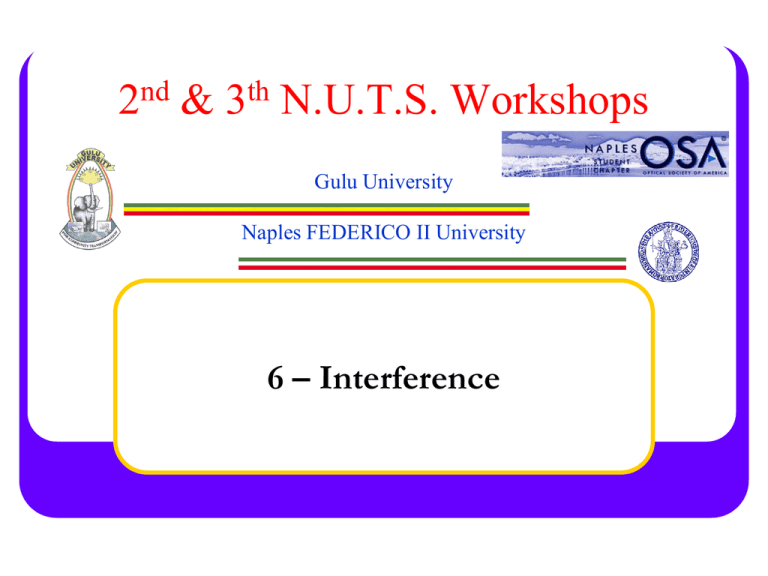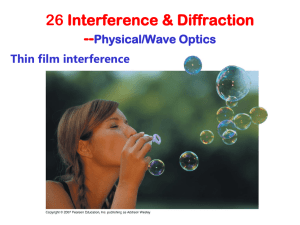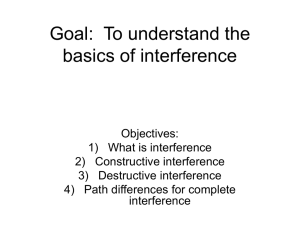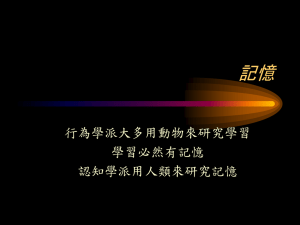6- Interference
advertisement

2nd & 3th N.U.T.S. Workshops Gulu University Naples FEDERICO II University 6 – Interference 2nd & 3th NUTS Workshop ( Jan 2010) Soap Bubbles … and Oil Spot What is producing so nice colours ? 6- Interference 2 2nd & 3th NUTS Workshop ( Jan 2010) Other Examples of Nice Coulours … 6- Interference 3 2nd & 3th NUTS Workshop ( Jan 2010) It’s just a Phase Difference Pattern! or a Thin Film Interference Constructive and destructive interference of light waves is the reason why thin films, such as soap bubbles, show colorful patterns. Light waves reflecting off the top surface of a film interfere with the waves reflecting from the bottom surface. To obtain a nice colored pattern, the thickness of the film has to be of the order of the wavelength of light. Variable thickness of the film give variable wavelength (colour) of the refracted light constructive interference 6- Interference 4 2nd & 3th NUTS Workshop ( Jan 2010) What is Interference? Combined Waveform wave 1 wave 2 If two waves (same wavelength and frequency) are in phase, both wave crests and troughs align. Constructive interference results increase in the wave amplitude, for light a brightening of the waveform in that location. If the two waves are out of phase, then the crests will align with the troughs. Destructive Interference results, a decrease in the amplitude of the combined wave, for light a dimming of the waveform at that location. 6- Interference 5 2nd & 3th NUTS Workshop ( Jan 2010) Interference: SUPERPOSITION of 2 or more Waves in the same region ONLY UNDER SPECIFIC CONDITIONS 6- Interference 6 2nd & 3th NUTS Workshop ( Jan 2010) Conditions to Have Interference In the simplest case: Superposition of periodic waves with same frequency. The waves’ sources oscillate in phase. i.e. synchronously, or with phase difference constant and known (COHERENT SOURCES) 6- Interference 7 2nd & 3th NUTS Workshop ( Jan 2010) Example of Incoherent Light Source 6- Interference 8 2nd & 3th NUTS Workshop ( Jan 2010) Interference for Coherent Sources (longitudinal and transversal waves) 6- Interference 9 2nd & 3th NUTS Workshop ( Jan 2010) Young’s Experiment The double-slit experiment, performed by the English scientist T. Young in 1801, is an attempt to resolve the question of whether light was composed of particles (Newton's "corpuscular" theory), or rather consisted of waves. The Interference Patterns observed in the experiment seemed to discredit the corpuscular theory; the wave theory of light remained well accepted until early 20th century. The original drawing by T. Young to illustrate its experiments. 6- Interference 10 2nd & 3th NUTS Workshop ( Jan 2010) Double-slit Experiment: Schema plane waveforms to focus on the screen To have a constructive interference along the θ direction the path length difference between the wavefronts coming from the two apertures have to be an integer number of wavelengths: dsinθ= mλ 6- Interference 11 2nd & 3th NUTS Workshop ( Jan 2010) Another Schema of Young Experiment 6- Interference 12 2nd & 3th NUTS Workshop ( Jan 2010) YOUNG Ex conditions for MAX and MIN Intensity BRIGHT FRINGE : DARK FRINGE : 6- Interference 13 2nd & 3th NUTS Workshop ( Jan 2010) Geometry of N-slits Interference N rj x′ j θ a L 2 λ d 1 6- Interference x d = spacing between two slits L = screen distance from the plane of the slits N = total number of slits = angle between the direction of incoming beam and the considered out coming one = wavelength of the incident light 14 2nd & 3th NUTS Workshop ( Jan 2010) N-slits Interference: the Solution for I Nd sin sin I ( ) I 0 sin d sin 2 2 slits 5 slits Interference of red laser light 6- Interference 15 2nd & 3th NUTS Workshop ( Jan 2010) Double-slit Maxima Location sin 2 d sin / I ( ) I 0 sin d sin / Maxima when denominator = 0 d sin n sin n 2 n is the fringe order d - n is a positive o negative integer - there is a nmax (nmax= max integer ≤d/λ) - total number of fringes =2 nmax+1 (from -nmax to +nmax ) 6- Interference 16 2nd & 3th NUTS Workshop ( Jan 2010) 5-slits Versus Double Slit sin 5 d sin / I ( ) I 0 sin d sin / Maxima 5-slit when denominator = 0 d sin same as 2-slit!!! n sin n d 2 only the fringe width is narrower with respect to 2-slit (the fringe width is proportional to the numerator period!) 2 slits 5 slits Interference of red laser light 6- Interference 17 2nd & 3th NUTS Workshop ( Jan 2010) Multi-slits Interference We Will Work on to build a low cost spectroscope 6- Interference 18







